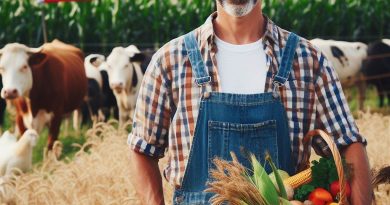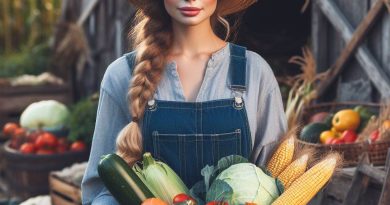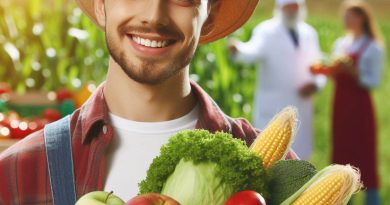Farm-to-Table: A CSA Journey
Last Updated on March 2, 2024
Introduction
Farm-to-table is a concept that promotes local and sustainable agriculture, connecting farmers directly to consumers.
CSA, or Community Supported Agriculture, is a way for people to directly support local farms by purchasing a share of the harvest.
By participating in CSA, consumers help ensure a reliable income for farmers and access to fresh, organic produce.
Supporting local farmers and sustainable agriculture is essential to preserve the environment, promote food security, and strengthen local economies.
What is a CSA?
Definition and purpose of CSA
A CSA, or Community Supported Agriculture, is a program that connects consumers with local farmers.
CSA members pay upfront for a share of the farm’s harvest, providing financial support to farmers throughout the season.
How CSA works
Farmers determine the number of shares available and the cost, and members sign up and pay in advance.
Throughout the growing season, members receive a weekly box filled with fresh, locally grown produce.
Benefits of joining a CSA program
- Access to fresh, seasonal produce: CSA members enjoy the freshest produce available, as the crops are harvested at peak ripeness. Each week’s box contains a variety of vegetables, fruits, flowers, and sometimes even eggs or dairy products.
- Supporting local farmers directly: By joining a CSA, individuals contribute directly to the financial stability of local farmers. This direct support allows farmers to focus on their work and avoid dependence on large-scale distributors or middlemen.
- Reduced environmental impact: With CSA, the produce travels shorter distances from farm to table, reducing carbon emissions and energy consumption. It helps to minimize the environmental impact associated with long-haul transportation and industrial farming practices.
- Strengthening community bonds: CSA fosters a sense of community by connecting people with the source of their food. Members have the opportunity to interact with the farmers, visit the farm, and take part in events or workshops. Joining a CSA program offers a chance to connect with like-minded individuals who value sustainable agriculture.
Overall, CSA creates a mutually beneficial relationship between farmers and consumers, serving both parties’ needs.
Read: Benefits of Joining a CSA
Researching and Choosing a CSA
Local farm options
When researching CSAs, it’s important to consider the farms that are located in your area.
Look for farms that are close to your home or workplace, as this will make it more convenient for you to pick up your produce each week.
Factors to consider when selecting a CSA
- Farming practices: It’s essential to choose a CSA that follows sustainable and organic farming practices. You want to support farms that prioritize the health of the environment and prioritize the well-being of their plants and animals.
- Produce variety and diversity: Check if the CSA offers a diverse range of fruits, vegetables, and herbs throughout the season. This ensures that you’ll have a variety of fresh, seasonal produce in your weekly share.
- Pickup/delivery options and convenience: Determine if the CSA offers different pickup or delivery options to fit your schedule. Some CSAs have designated pickup locations, while others may deliver directly to your doorstep.
- Cost and payment plans: Consider the cost of the CSA share and the available payment plans. Some CSAs offer different sizes of shares or payment options, such as monthly or full-season payments. Choose the option that best fits your budget.
- Member requirements and expectations: Find out if the CSA has any member requirements or expectations. Some CSAs may require a certain level of volunteer hours or participation in events. Make sure you are comfortable with these requirements.
Reading reviews and testimonials
- Before making your final decision, take the time to read reviews and testimonials from current and past members.
- This will give you insights into the CSA’s quality of produce, service, and overall member satisfaction.
Visiting the farm or attending open-house events
- If possible, try to visit the farm or attend any open-house events they may have.
- This will give you a chance to see the farm in person, meet the farmers, and get a better sense of their operations and practices.
By following these steps and considering the factors mentioned, you can ensure that you choose a CSA that aligns with your values and provides you with high-quality, fresh produce throughout the season.
Read: Find Your Local CSA: A Guide
Joining a CSA and the Journey Begins!
As you sign up and become a member of a Community Supported Agriculture (CSA) program, the adventure of connecting with local farmers and enjoying fresh, seasonal produce unfolds.
Here’s a glimpse into the journey as you actively participate in a CSA:
Signing up and becoming a member
- The first step is to sign up and become a CSA member.
- This direct connection with local farmers ensures a regular supply of fresh produce while supporting sustainable agricultural practices.
Understanding the farming calendar and seasonal availability
- Understanding the farming calendar is crucial.
- Align your expectations with the ebb and flow of seasons, anticipating the unique delights each harvest brings.
Communication with the farm and weekly newsletters
- Communication is key.
- Stay informed through weekly newsletters from the farm.
- These updates provide insights into farming practices, upcoming crops, and any exciting news from the agricultural front.
Pickup or delivery experiences
Deciding between picking up your CSA share or having it delivered brings different experiences and benefits.
- Getting to know the farmers and fellow members: Pickup experiences offer more than just vegetables.
Engage with the farmers and fellow members, building a sense of community around the shared appreciation for locally sourced, fresh produce. - Exploring the farm during pickup visits: Some CSAs allow members to explore the farm during pickup visits, providing an up-close look at the fields where your food is grown.
- Challenges and rewards of maintaining a schedule: Embrace the challenges and rewards of maintaining a schedule for pickups or deliveries.
While it might require some planning, the benefits of enjoying fresh, seasonal produce and fostering a connection with local agriculture far outweigh the effort.
As you embark on this CSA journey, each pickup becomes a chapter in your farm-to-table story, filled with connections, discoveries, and a deeper appreciation for the journey from farm to your dinner plate.
Read: CSA 101: Basics for Beginners
Unpacking the CSA Produce Box
Welch on the variety of produce received
- Opening the CSA produce box is like unwrapping a surprise gift every week.
- The box is filled with a diverse array of fresh fruits and vegetables.
- From leafy greens to vibrant tomatoes, the variety never ceases to amaze me.
- It’s exciting to try new vegetables and experiment with different flavors in my dishes.
Recipe ideas and cooking with unfamiliar ingredients
- Each CSA box is an opportunity to broaden my culinary horizons.
- I research recipes online and flip through cookbooks for inspiration.
- Cooking with unfamiliar ingredients pushes me out of my comfort zone.
- I’ve discovered delicious recipes like beet and goat cheese salad and zucchini noodles.
- It’s rewarding to create nutritious meals using the produce straight from the farm.
Sharing surplus or trading with other members
- The CSA community is more than just receiving a box of produce.
- When I have surplus produce, I love to share it with other members.
- We have a strong sense of camaraderie and support each other.
- Some members even organize produce swaps, where we can trade items we don’t need.
- It’s a great way to connect with others who share a passion for fresh, local food.
Adjusting meal plans based on the box contents
- Meal planning becomes an exciting challenge with the CSA produce box.
- Instead of deciding what to cook and buying ingredients, it’s the other way around.
- I have to adapt my meal plans to accommodate the contents of the box.
- It forces me to be creative and flexible, which enhances my cooking skills.
- Adjusting my meal plans also ensures that I make the most of every vegetable.
Unpacking the CSA produce box is an adventure that goes far beyond the surface.
It has opened my eyes to the beauty of fresh, local produce and the joys of cooking with seasonal ingredients.
Each box brings new flavors, new connections, and an enriched appreciation for the farm-to-table journey.
Read: The Farm-to-Table Movement in DC

Experiencing the Benefits of Farm-to-Table CSA
Improving dietary habits and nutrition
- Farm-to-table CSA encourages consuming fresh, organic produce, leading to improved overall dietary habits.
- By supporting local farms, CSA members have access to nutrient-dense fruits and vegetables.
- The abundance of healthy options in a CSA share encourages individuals to incorporate more fruits and vegetables into their diet.
- Farm-fresh produce provides higher levels of essential vitamins, minerals, and antioxidants, boosting nutrition.
- Eating a variety of seasonal produce from a CSA helps diversify one’s diet and promotes a healthier lifestyle.
Embracing seasonal eating and creative cooking
- CSA members learn to embrace the ebb and flow of seasonal produce availability.
- Seasonal eating encourages creativity in the kitchen through experimenting with different flavors and recipes.
- By adapting recipes to fit the available produce, CSA members learn to cook outside their comfort zones.
- The unpredictability of a CSA share challenges individuals to develop new culinary skills and broaden their cooking repertoire.
- Embracing seasonal eating promotes a greater appreciation for nature’s offerings and fosters a connection with the seasons.
Developing a deeper connection with the food
- Participating in a farm-to-table CSA provides a profound understanding of where food comes from.
- Visiting the farm and engaging with the farmers fosters a deeper connection and appreciation for the food.
- CSA members witness the hard work and dedication required for sustainable, organic farming.
- Harvesting one’s own produce or meeting the farmers who grow it creates a sense of pride and connection.
- Developing a connection with the food source enhances mindfulness and gratitude towards the meals consumed.
Supporting sustainable agriculture and local economy
- Joining a farm-to-table CSA helps in sustaining local agriculture and preserving farmland.
- By purchasing directly from farmers, CSA members promote sustainable farming practices and reduce carbon footprint.
- Supporting local farmers aids in strengthening the local economy and fosters a sense of community.
- CSA subscriptions provide financial stability for farmers, allowing them to plan ahead and invest in sustainable farming methods.
- By actively participating in the farm-to-table movement, individuals contribute to the preservation of traditional farming methods.
Inspiring positive lifestyle changes
- Engaging in a farm-to-table CSA cultivates a heightened sense of environmental consciousness.
- The experience of supporting local farmers may inspire individuals to seek out other sustainable and ethical products.
- Through the CSA, individuals may discover new foods and cooking techniques that enhance their culinary skills.
- Sharing the farm-to-table experience with family and friends encourages healthy eating and sustainable lifestyle choices.
- Being part of a farm-to-table CSA sparks a sense of pride and empowerment, motivating individuals to advocate for sustainable food systems.
Overcoming Challenges and Lessons Learned
Dealing with abundance or scarcity of certain crops
- In the CSA journey, we have encountered situations where we have had an overwhelming abundance of certain crops.
- On the other hand, there have been times when certain crops have been scarce due to weather conditions or other factors.
- To deal with abundance, we have learned the importance of sharing with others and donating excess produce to local food banks.
- During times of scarcity, we have had to get creative with meal planning and make the most out of what we have.
- Learning to appreciate both abundance and scarcity has helped us gain a deeper understanding of the farming process and the unpredictability of nature.
Learning to preserve or freeze excess produce
- To make sure we make the most out of the abundance during harvest season, we have learned the art of preservation.
- Canning, pickling, and freezing excess produce have become essential skills in our CSA journey.
- Preserving allows us to enjoy the fresh flavors of the farm throughout the year and reduces waste.
- We have discovered various recipes and methods for preserving different types of fruits and vegetables.
- Through trial and error, we have honed our preservation techniques and found the ones that work best for us.
Becoming more resourceful and reducing food waste
- Engaging in a CSA journey has taught us the value of every piece of produce we receive.
- We have become more resourceful in using every part of the vegetables and fruits we get.
- Stems and leaves that were once discarded are now turned into delicious stocks and soups.
- Fruit peels are used to infuse flavor into desserts and sauces.
- By reducing food waste, we not only save money but also contribute to a more sustainable food system.
Adapting to unfamiliar or unique vegetables/fruits
- One of the exciting aspects of the CSA journey is the opportunity to try new and unfamiliar vegetables and fruits.
- At first, we may have been unsure about how to prepare and cook these unique produce items.
- However, over time, we have learned to experiment and find new recipes that highlight the flavors of these unfamiliar ingredients.
- Adapting to unfamiliar produce has expanded our culinary horizons and encouraged us to step out of our comfort zones.
- Now, we look forward to the surprises that each CSA box brings.
Balancing meal planning and flexibility
- Meal planning is an essential part of making the most out of our CSA subscription.
- However, we have also learned the importance of flexibility in our meal plans.
- As the availability of certain crops changes each week, we have had to adapt and adjust our meal plans accordingly.
- Being open to switching things around and trying new recipes has added excitement and spontaneity to our meals.
- By finding a balance between meal planning and flexibility, we have maximized the benefits of our CSA journey.
Delve into the Subject: 2024’s Top Farm-to-Table Workshops Nationwide
Conclusion
Throughout this blog post, we have followed the exciting journey of joining a CSA.
From signing up and receiving our first box of fresh, locally sourced produce, to exploring new recipes and enjoying the delicious flavors of the farm-to-table movement.
Now, it’s time to encourage you, our readers, to consider joining your local CSA.
By becoming a member, you not only support local farmers and their sustainable practices but also gain access to nutrient-rich, seasonal produce.
The Farm-to-Table movement is more than just a trend; it’s a way of life that promotes a healthier, more sustainable food system.
By supporting local farmers and eating fresh, seasonal ingredients, we contribute to a greener environment and our own wellbeing.
As we conclude our CSA journey, let us remember the importance of supporting sustainable agriculture.
Whether it’s by joining a CSA, shopping at farmers markets, or growing our own food, every action we take makes a difference in creating a more sustainable and resilient food system.
Let’s make conscious choices and support the future of our planet and health.


